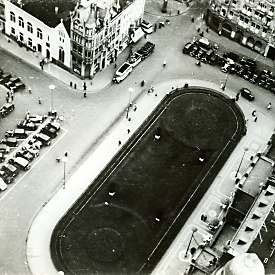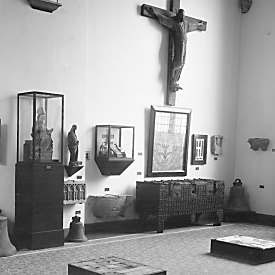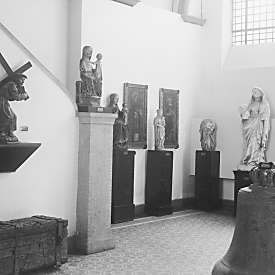1923 – 1939
1923 – 1939
Rebuilding and reorganisation of the museum
Wilhelm Neuß and Jakob Eschweiler
As the president of the Society for Christian Art, Bonn church historian Wilhelm Neuß became director of the Diözesanmuseum on 14 October 1923. The two posts, which had been run by the same people up to that time, were separated when Jakob Eschweiler became director of the Diözesanmuseum in 1926. Neuß took an important step towards the modern age when he changed statutes of the society and the museum, abolishing the gothic ideal. In 1927, the new director, Jakob Eschweiler, who also led the “Institut für religiöse Kunst” (Institute for Religious Art) as the successor of Witte, was able to finish the reconstruction of the building on the basis of plans by the architect Eduard Endler as well as conclude an extensive reorganisation of the museum. The final measures in this undertaking were completed in 1936. At the same time, the first scientific catalogue of the collection was sent out to the members of the society as a kind of gift of art. The museum managed to avoid the otherwise mandatory membership in the Board of Fine Arts by pointing to its membership in the diocesan authorities. During the struggle between Church and State under Bismarck, they had used precisely the opposite argument. At the outbreak of the Second World War on 1 September 1939 the museum was closed.
Rebuilding and reorganisation of the museum
Wilhelm Neuß and Jakob Eschweiler
As the president of the Society for Christian Art, Bonn church historian Wilhelm Neuß became director of the Diözesanmuseum on 14 October 1923. The two posts, which had been run by the same people up to that time, were separated when Jakob Eschweiler became director of the Diözesanmuseum in 1926. Neuß took an important step towards the modern age when he changed statutes of the society and the museum, abolishing the gothic ideal. In 1927, the new director, Jakob Eschweiler, who also led the “Institut für religiöse Kunst” (Institute for Religious Art) as the successor of Witte, was able to finish the reconstruction of the building on the basis of plans by the architect Eduard Endler as well as conclude an extensive reorganisation of the museum. The final measures in this undertaking were completed in 1936. At the same time, the first scientific catalogue of the collection was sent out to the members of the society as a kind of gift of art. The museum managed to avoid the otherwise mandatory membership in the Board of Fine Arts by pointing to its membership in the diocesan authorities. During the struggle between Church and State under Bismarck, they had used precisely the opposite argument. At the outbreak of the Second World War on 1 September 1939 the museum was closed.




